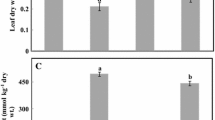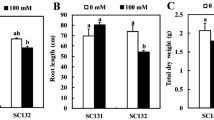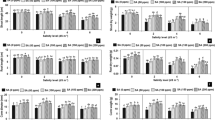Abstract
Addressing salinity-induced crop losses is a prime concern of modern agriculture to sustain agricultural productivity, thereby contributing to global food security. The current study explored the potential roles of salicylic acid (SA) in the improvement of maize tolerance to salinity, and evaluated the resultant effects on yield-associated parameters and yield. Our results showed that maize plants grown under salinity alone exhibited severely compromised growth performance, and consequently yield loss, which could be attributed to reduced plant height, decreased photosynthetic efficiency, and elevated levels of the lipid peroxidation product malondialdehyde in maize leaves. On the other hand, foliar application of SA minimized the detrimental effects of salinity in salt-exposed plants, leading to better growth performance and yield when compared with SA-free salt-stressed plants. SA-mediated beneficial effects were particularly evident in the enhancement of photosynthesis-related parameters, including photosynthetic rate, carboxylation efficiency, water use efficiency, and chlorophyll content (SPAD value). Exogenous SA also contributed to the reduction of membrane damage under salinity, as reflected by significantly decreased levels of malondialdehyde in the leaves of maize exposed to salt stress. Furthermore, activities of enzymatic antioxidants like ascorbate peroxidase and catalase in maize leaves were significantly enhanced following SA application in salt-exposed plants, indicating a protective role of SA against salt-induced oxidative stress. Finally, clustering and principal component analysis revealed that the antioxidant capacity and photosynthetic efficiency were intimately associated with the salt and SA treatments. Our findings demonstrate that foliar application of SA is a viable option in alleviating the adverse effects of salinity on growth performance and yield of maize, as well as other economically important crops cultivated in salt-affected areas.




Similar content being viewed by others
References
Abbasi H, Jamil M, Haq A, Ali S, Ahmad R, Malik Z (2016) Salt stress manifestation on plants, mechanism of salt tolerance and potassium role in alleviating it: a review. Zemdirbyste 103:229–238
Acosta-Motos J, Ortuño M, Bernal-Vicente A, Diaz-Vivancos P, Sanchez-Blanco M, Hernandez J (2017) Plant responses to salt stress: adaptive mechanisms. Agronomy 7:18
Aebi H (1984) Catalase in vitro. Methods Enzymol 105:121–126
Ahanger MA, Tyagi SR, Wani MR, Ahmad P (2014) Drought tolerance: role of organic osmolytes, growth regulators, and mineral nutrients. In: Ahmad P, Wani MR (eds) Physiological mechanisms and adaptation strategies in plants under changing environment. Springer, New York, pp 25–55
Ahmad P, Jaleel CA, Salem MA, Nabi G, Sharma S (2010) Roles of enzymatic and nonenzymatic antioxidants in plants during abiotic stress. Crit Rev Biotechnol 30:161–175
Ahmad F, Singh A, Kamal A (2017) Ameliorative effect of salicylic acid in salinity stressed Pisum sativum by improving growth parameters, activating photosynthesis and enhancing antioxidant defense system. Biosci Biotech Res Comm 10:481–489
Ahmad P, Alyemeni MN, Ahanger MA, Egamberdieva D, Wijaya L, Alam P (2018) Salicylic acid (SA) induced alteations in growth, biochemical attributes and antioxidant enzyme activity in faba bean (Vicia faba L.) seedlings under NaCl toxicity. Russ J Plant Physiol 65:104–114
Akram S, Siddiqui MN, Hussain BMN, Bari MA, Mostofa MG, Hossain MA, Tran LSP (2017) Exogenous glutathione modulates salinity tolerance of soybean [Glycine max (L.) Merrill] at reproductive stage. J Plant Growth Regul 36:877–888
Ali Q, Athar HR, Ashraf M (2008) Modulation of growth, photosynthetic capacity and water relations in salt stressed wheat plants by exogenously applied 24-epibrassinolide. Plant Growth Regul 56:107–116
Anjum NA, Gill SS, Gill R (2014) Plant adaptation to environmental change: significance of amino acids and their derivatives. CABI, Wallingford
Azooz MM, Youssef AM, Ahmad P (2011) Evaluation of salicylic acid (SA) application on growth, osmotic solutes and antioxidant enzyme activities on broad bean seedlings grown under diluted seawater. Int J Plant Physiol Biochem 3:253–264
BBS (Bangladesh Bureau of Statistics) (2018) Yearbook of agricultural statistics of Bangladesh 2017. Statistics Division, Ministry of Planning, Government of the People’s Republic of Bangladesh, Dhaka
Belkadhi A, De Haro A, Soengas P, Obregon S, Cartea ME, Chaibi W, Djebali W (2014) Salicylic acid increases tolerance to oxidative stress induced by hydrogen peroxide accumulation in leaves of cadmium-exposed flax (Linum usitatissimum L.). J Plant Interact 9:647–654
Bose J, Rodrigo-Moreno A, Shabala S (2014) ROS homeostasis in halophytes in the context of salinity stress tolerance. J Exp Bot 65:1241–1257
Chartzoulakis KS (2005) Salinity and olive: growth, salt tolerance, photosynthesis and yield. Agric Water Manag 78:108–121
Chaves MM, Flexas J, Pinheiro C (2009) Photosynthesis under drought and salt stress: regulation mechanisms from whole plant to cell. Ann Bot 103:551–560
Choudhury FK, Rivero RM, Blumwald E, Mittler R (2017) Reactive oxygen species, abiotic stress and stress combination. Plant J 90:856–867
Das K, Roychoudhury A (2014) Reactive oxygen species (ROS) and response of antioxidants as ROS-scavengers during environmental stress in plants. Front Environ Sci 2:53
de Freitas PA, de Souza Miranda R, Marques EC, Prisco JT, Gomes-Filho E (2018) Salt tolerance induced by exogenous proline in maize is related to low oxidative damage and favorable ionic homeostasis. J Plant Growth Regul 37:911–924
Deinlein U, Stephan AB, Horie T, Luo W, Xu G, Schroeder JI (2014) Plant salt-tolerance mechanisms. Trends Plant Sci 19:371–379
Dempsey DA, Klessig DF (2017) How does the multifaceted plant hormone salicylic acid combat disease in plants and are similar mechanisms utilized in humans? BMC Biol 15:23
Dias KG, de L, Guimarães, Neto PTG, Silveira AEF, HRO de, Lacerda JJ de J (2017) Effect of magnesium on gas exchange and photosynthetic efficiency of coffee plants grown under different light levels. Agriculture 7:85
Faghih S, Ghobadi C, Zarei A (2017) Response of strawberry plant cv. ‘Camarosa’ to salicylic acid and methyl jasmonate application under salt stress condition. J Plant Growth Regul 36:651–659
Fariduddin Q, Hayat S, Ahmad A (2003) Salicylic acid influences net photosynthetic rate, carboxylation efficiency, nitrate reductase activity, and seed yield in Brassica juncea. Photosynthetica 41:281–284
Food and Agriculture Organization (2016) FAO soils portal. http://www.fao.org/soils-portal/soil-management/management-of-some-problem-soils/salt-affected-soils/more-information-on-salt-affected-soils/en. Accessed 29 Aug 2018
Foyer CH, Shigeoka S (2011) Understanding oxidative stress and antioxidant functions to enhance photosynthesis. Plant Physiol 155:93–100
Gallardo B, Bogan AE, Harun S, Jainih L, Lopes-Lima M, Pizarro M, Rahim KA, Sousa R, Virdis SGP, Zieritz A (2018) Current and future effects of global change on a hotspot’s freshwater diversity. Sci Total Environ 635:750–760
Garg N, Manchanda G (2009) ROS generation in plants: boon or bane? Plant Biosyst 143:81–96
Gupta B, Huang B (2014) Mechanism of salinity tolerance in plants: physiological, biochemical, and molecular characterization. Int J Genomics 2014:701596
Hanin M, Ebel C, Ngom M, Laplaze L, Masmoudi K (2016) New insights on plant salt tolerance mechanisms and their potential use for breeding. Front Plant Sci 7:1787
Hasanuzzaman M, Nahar K, Fujita M (2013) Plant response to salt stress and role of exogenous protectants to mitigate salt-induced damages. In: Ahmad P, Azooz M, Prasad M (eds) Ecophysiology and responses of plants under salt stress. Springer, New York, pp 25–87
Heath RL, Packer L (1968) Photoperoxidation in isolated chloroplasts: I. kinetics and stoichiometry of fatty acid peroxidation. Arch Biochem Biophys 125:189–198
Hernández JA, Diaz-Vivancos P, Barba-Espín G, Clemente-Moreno MJ (2017) On the role of salicylic acid in plant responses to environmental stresses. In: In: Nazar R et al (eds) Salicylic acid: a multifaceted hormone. Springer, Singapore, pp 17–34
Hoque MA, Okuma E, Banu MN, Nakamura Y, Shimoishi Y, Murata Y (2007) Exogenous proline mitigates the detrimental effects of salt stress more than exogenous betaine by increasing antioxidant enzyme activities. J Plant Physiol 164:553–561
Jini D, Joseph B (2017) Physiological mechanism of salicylic acid for alleviation of salt stress in rice. Rice Sci 24:97–108
Khan NA, Nazar R, Iqbal N, Anjum NA (2012) Phytohormones and abiotic stress tolerance in plants. Springer, Berlin
Khan MIR, Asgher M, Khan NA (2014) Alleviation of salt-induced photosynthesis and growth inhibition by salicylic acid involves glycinebetaine and ethylene in mungbean (Vigna radiata L.). Plant Physiol Biochem 80:67–74
Khan MI, Fatma M, Per TS, Anjum NA, Khan NA (2015) Salicylic acid-induced abiotic stress tolerance and underlying mechanisms in plants. Front Plant Sci 6:462
Khoshbakht D, Asgharei MR (2015) Influence of foliar-applied salicylic acid on growth, gas-exchange characteristics, and chlorophyll fluorescence in citrus under saline conditions. Photosynthetica 53:410–418
Kim Y, Kim S, Shim IS (2017) Exogenous salicylic acid alleviates salt-stress damage in cucumber under moderate nitrogen conditions by controlling endogenous salicylic acid levels. Hortic Environ Biotechnol 58:247–253
Li G, Peng X, Wei L, Kang G (2013) Salicylic acid increases the contents of glutathione and ascorbate and temporally regulates the related gene expression in salt-stressed wheat seedlings. Gene 529:321–325
Li Y, Li H, Li Y, Zhang S (2017) Improving water-use efficiency by decreasing stomatal conductance and transpiration rate to maintain higher ear photosynthetic rate in drought-resistant wheat. Crop J 5:231–239
Liu H, Song J, Dong L, Wang D, Zhang S, Liu J (2017) Physiological responses of three soybean species (Glycine soja. G. gracilis, and G. max cv. Melrose) to salinity stress. J Plant Res 130:723
Maswada HF, Djanaguiraman M, Prasad PVV (2018) Response of photosynthetic performance, water relations and osmotic adjustment to salinity acclimation in two wheat cultivars. Acta Physiol Plant 40:105
Medrano H, Tomás M, Martorell S, Flexas J, Hernández E, Rosselló J, Pou A, Escalona JM, Bota J (2015) From leaf to whole-plant water use efficiency (WUE) in complex canopies: limitations of leaf WUE as a selection target. Crop J 3:220–228
Miller G, Suzuki N, Ciftci-yilmaz S, Mittler R (2010) Reactive oxygen species homeostasis and signalling during drought and salinity stresses. Plant Cell Environ 33:453–467
Monostori I, Árendás T, Hoffman B, Galiba G, Gierczik K, Szira F, Vágújfalvi A (2016) Relationship between SPAD value and grain yield can be affected by cultivar, environment and soil nitrogen content in wheat. Euphytica 211:103–112
Moslehuddin AZ, Abedin MA, Hossain MA, Habiba U (2015) Soil health and food security: perspective from southwestern coastal region of Bangladesh. In: Moslehuddin AZ, Abedin MA, Hossain MA, Habiba U (eds) Food security and risk reduction in Bangladesh. Springer, Tokyo, pp 187–212
Mostofa MG, Fujita M (2013) Salicylic acid alleviates copper toxicity in rice (Oryza sativa L.) seedlings by up-regulating antioxidative and glyoxalase systems. Ecotoxicology 22:959–973
Mostofa MG, Hossain MA, Fujita M (2014) Trehalose pretreatment induces salt tolerance in rice (Oryza sativa L.) seedlings: oxidative damage and co-induction of antioxidant defense and glyoxalase systems. Protoplasma 252:461–475
Mostofa MG, Saegusa D, Fujita M, Tran LSP (2015) Hydrogen sulfide regulates salt tolerance in rice by maintaining Na+/K+ balance, mineral homeostasis and oxidative metabolism under excessive salt stress. Front Plant Sci 6:1055
Mottaleb KA, Kruseman G, Erenstein O (2018) Determinants of maize cultivation in a land-scarce rice-based economy: the case of Bangladesh. J Crop Improv 32:453–476
Munns R, Tester M (2008) Mechanisms of salinity tolerance. Annu Rev Plant Biol 59:651–681
Murad KFI, Hossain A, Fakir OA, Biswas SK, Kumer K, Rannu RP, Timsina J (2018) Conjunctive use of saline and fresh water increases the productivity of maize in saline coastal region of Bangladesh. Agric Water Manag 204:262–270
Nakano Y, Asada K (1981) Hydrogen peroxide is scavenged by ascorbate-specific peroxidase in spinach chloroplasts. Plant Cell Physiol 22:867–880
Nazar R, Iqbal N, Syeed S, Khan NA (2011) Salicylic acid alleviates decreases in photosynthesis under salt stress by enhancing nitrogen and sulfur assimilation and antioxidant metabolism differentially in two mungbean cultivars. J Plant Physiol 168:807–815
Nazar R, Umar S, Khan NA, Sareer O (2015) Salicylic acid supplementation improves photosynthesis and growth in mustard through changes in proline accumulation and ethylene formation under drought stress. S Afr J Bot 98:84–94
Nazar R, Iqbal N, Umar S (2017) Heat stress tolerance in plants: action of salicylic acid. In: Nazar R et al (eds) Salicylic acid: a multifaceted hormone. Springer, Singapore, pp 145–161
Negrão S, Schmöckel SM, Tester M (2017) Evaluating physiological responses of plants to salinity stress. Ann Bot 119:1–11
Nguyen KH, Mostofa MG, Li W, Van Ha C, Watanabe Y, Le DT, Thao NP, Tran LSP (2018) The soybean transcription factor GmNAC085 enhances drought tolerance in Arabidopsis. Environ Exp Bot 151:12–20
Nie W, Gong B, Chen Y, Wang J, Wei M, Shi Q (2018) Photosynthetic capacity, ion homeostasis and reactive oxygen metabolism were involved in exogenous salicylic acid increasing cucumber seedlings tolerance to alkaline stress. Sci Hort 235:413–423
Niinemets Ü, Díaz-Espejo A, Flexas J, Galmés J, Warren CR (2009) Role of mesophyll diffusion conductance in constraining potential photosynthetic productivity in the field. J Exp Bot 60:2249–2270
Nooren S, Fatima K, Athar HUR, Ahmad S, Hussain K (2017) Enhancement of physio-biochemical parameters of wheat through exogenous application of salicylic acid under drought stress. J Anim Plant Sci 27:153–163
Parashar A, Yusuf M, Fariduddin Q, Ahmad A (2014) Salicylic acid enhances antioxidant system in Brassica juncea grown under different levels of manganese. Int J Biol Macromol 70:551–558
Parihar P, Singh S, Singh R, Singh VP, Prasad SM (2015) Effect of salinity stress on plants and its tolerance strategies: a review. Environ Sci Pollut Res 22:4056–4075
Pirasteh-Anosheh H, Emam Y (2018) Modulation of oxidative damage due to salt stress using salicylic acid in Hordeum vulgare. Arch Agron Soil Sci 64:1268–1277
Qiu Z, Guo J, Zhu A, Zhang L, Zhang M (2014) Exogenous jasmonic acid can enhance tolerance of wheat seedlings to salt stress. Ecotoxicol Environ Saf 104:202–208
Rady MM, Taha RS, Semida WM, Alharby FH (2017) Modulation of salt stress effects on Vicia faba L. plants grown on a reclaimed-saline soil by salicylic acid application. Romanian Agric Res 34:175–185
Rahman MM, Rahman MA, Miah MG, Saha SR, Karim MA, Mostofa MG (2017) Mechanistic insight into salt tolerance of Acacia auriculiformis: the importance of ion selectivity, osmoprotection, tissue tolerance, and Na+ exclusion. Front Plant Sci 8:155
Rouphael Y, Raimondi G, Lucini L, Carillo P, Kyriacou MC, Colla G, Cirillo V, Pannico A, El-Nakhel C, Pascale SD (2018) Physiological and metabolic responses triggered by omeprazole improve tomato plant tolerance to NaCl stress. Front Plant Sci 9:249
Shah SH, Houborg R, McCabe MF (2017) Response of chlorophyll, carotenoid and SPAD-502 measurement to salinity and nutrient stress in wheat (Triticum aestivum L.). Agronomy 7:61
Shahbaz M, Abid A, Masood A, Waraich EA (2017) Foliar-applied trehalose modulates growth, mineral nutrition, photosynthetic ability, and oxidative defense system of rice (Oryza sativa L.) under saline stress. J Plant Nutr 40:584–599
Siddiqui MN, Mostofa MG, Akter MM, Srivastava AK, Sayed MA, Hasan MS, Tran LSP (2017) Impact of salt-induced toxicity on growth and yield-potential of local wheat cultivars: oxidative stress and ion toxicity are among the major determinants of salt-tolerant capacity. Chemosphere 187:385–394
Sofo A, Scopa A, Nuzzaci M, Vitti A (2015) Ascorbate peroxidase and catalase activities and their genetic regulation in plants subjected to drought and salinity stresses. Int J Mol Sci 16:13561–13578
Soundararajan P, Manivannan A, Ko CH, Jeong BR (2018) Silicon enhanced redox homeostasis and protein expression to mitigate the salinity stress in Rosa hybrida ‘Rock Fire’. J Plant Growth Regul 37:16–34
Suhaib M, Ahmad I, Munir M, Iqbal MB, Abuzar MK, Ali S (2018) Salicylic acid induced physiological and ionic efficiency in wheat under salt stress. Pak J Agric Sci 31:79–85
Tanveer M, Shabala S (2018) Targeting redox regulatory mechanisms for salinity stress tolerance in crops. In: Salinity responses and tolerance in plants. Springer, Cham, pp 213–234
Tari I, Csiszár J, Horváth E, Poór P, Takács Z, Szepesi Á (2015) The alleviation of the adverse effects of salt stress in the tomato plant by salicylic acid shows a time-and organ-specific antioxidant response. Acta Biol 57:21–30
UN DESA (United Nations, Department of Economic and Social Affairs, Population division) (2015) World population prospect: the 2015 revision, Key findings and advance tables. Working Paper No. ESA/P/WP.241
Wu G-Q, Liang N, Feng R-J, Zhang J-J (2013) Evaluation of salinity tolerance in seedlings of sugar beet (Beta vulgaris L.) cultivars using proline, soluble sugars and cation accumulation criteria. Acta Physiol Plant 35:2665–2674
Acknowledgements
The authors gratefully acknowledge the constructive suggestions of Professor M. Afzal Hossain, Department of Biochemistry and Molecular Biology, Bangladesh Agricultural University, during manuscript preparation.
Author information
Authors and Affiliations
Corresponding authors
Ethics declarations
Conflict of interest
The authors declare that they have no conflict of interest.
Rights and permissions
About this article
Cite this article
Tahjib-Ul-Arif, M., Siddiqui, M.N., Sohag, A.A.M. et al. Salicylic Acid-Mediated Enhancement of Photosynthesis Attributes and Antioxidant Capacity Contributes to Yield Improvement of Maize Plants Under Salt Stress. J Plant Growth Regul 37, 1318–1330 (2018). https://doi.org/10.1007/s00344-018-9867-y
Received:
Accepted:
Published:
Issue Date:
DOI: https://doi.org/10.1007/s00344-018-9867-y




